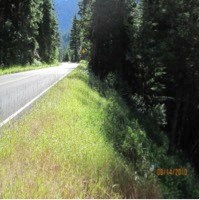Last updated: August 28, 2017
Article
Monitoring Federal Lands and Highway Program (FLHP) Revegetation Sites
For more than 20 years, the National Park Service Denver Service Center Transportation Division (NPS-DSC-T) Revegetation Program has been revegetating park roadsides disturbed by Federal Lands Highway Program (FLHP) and Emergency Repair Project (ERFO) construction projects with indigenous native seed and plants propagated from park collected germplasm by USDA- NRCS-PMCs.
The monitoring data to be collected would tell which species planted are doing best in the first 1-3 years following planting and which do better after 3 - to five years. It would also tell how quickly other native species move into these mixes on their own thereby reducing the need to include them in mixtures and thus the cost of seed. Mostly it would indicate trends…which species increase and provide erosion control, which decrease, which species dropout, and which maintain a stable presence during the 5-10 years after being planted. In addition, and most importantly, how well they suppress and interact with native and introduced invasive species.

2011 Mount Rainier Revegetation Monitoring Data
In 2010 two sites on the SR123 phase 1 FLHP Road Repair Project and two sites on the SR123 Emergency Repair Project (ERFO) were selected to be monitored for effectiveness of revegetation methods and use of native species for slope stability and erosion control. Monitoring data collection was conducted on 8/12/2010 and 9/6/2011. Following is the summary of transects located at Buttress # 1 and Wash out #2 monitoring sites. Monitoring will conducted on the four sites in 2012 and 2014.
Buttress #1- Summary of transects 1-6 data: Seeded Native Species percent frequency : Elymus glaucus , blue wildrye 77%; Bromus carinatus, California bromegrass 0%; Festuca rubra, red fescue 100%; Antenaria microphylla , pearly everlasting 25%; Abies amabilis, silver fir 25%
Non- Seeded Native Species percent frequency: Polygonum bistortoide, bistort 40%; Epilobium angustifolium, fireweed 28%, Invasive species percent frequency: Leucanthemum vulgare, oxeye daisy 19%; Lotus corniculatus, birdsfoot trefoil 22%
Bare Ground: 27%
Debris: 33%
Plant Cover : 12%
Wash out #2- Summary of transects 1-4: Seeded Native Species percent frequency: Elymus glaucus, blue wildrye 100%; Bromus carinatus, California bromegrass 16%; Festuca rubra, red fescue 22%; Epilobium angustifolium , fireweed 24%; Antenaria microphylla , pearly everlasting 17%; Abies amabilis, silver fir 31%,
Non seeded native species percent frequency : Carex sp, sedge sp. 33*%; Rubus parviflorus, thimbleberry 17%*; Oplopanax horridus, devils club 17%*; Adenocaulon bicolor , pathfinder 17%*
Invasive species: percent frequency Potentia sp. 33%; Trifolium repens, white clover 17%*
Plant Cover : 23%
Bare Ground: 33% *
Debris: 36%
Large Rock: 28%
Large Log: 19%
DISCUSSION: Effects of Buttress Construction and Revegetation Site Preparation
Buttress #1 involved placement of large boulders starting at base and proceeding up slope with slightly smaller boulders /rocks mixed in near top. Topsoil: 4” of salvaged mineral (very low organics) topsoil placed over the boulders/rocks as far down slope that could be reached with equipment (30ft?) Park personnel state that much of the topsoil that was applied fell into the voids caused by the spacing of the large boulders leaving little topsoil for plant growth near bottom of slope. Coverage improved as proceed up slope where the boulders/rocks were somewhat smaller to retain topsoil. As expected establishment , performance and survival of species reacted according to the amount of topsoil remaining.
Due to the lack of adequate quality/ quantity, salvaged soil could not be used for topsoil on buttress #4. Manufactured (20%OM vs 80% mineral) topsoil was prepared by contractor and 4" of topsoil was
placed over the boulders/rocks as far down slope that could be reached with equipment (30ft?). Park personnel state that much of the topsoil that was applied fell into the large voids created by the spacing of the large boulders leaving little topsoil for plant growth in those areas. Topsoil as well as vegetation coverage improved as proceed up slope where the boulders/rocks were somewhat smaller to retain topsoil.
However, it was noted that soil conditions were dry and vegetation coverage less in the manufactured soil compared to the salvaged topsoil. Revegetation would be better if the manufactured soil had less sand and more
O.M. to improve water holding capacity.
Wash outs #2 & 5. Experience from working with the buttresses the previous year was used to repair and revegetate damaged areas. Rock and boulder placement included smaller materials to fill voids left by large boulders the entire length of slope. Six inches of manufactured topsoil, composed of 40%OM 60% mineral (see project write up for components) compared to 20% OM 80% mineral on buttresses #4, was placed the entire length of slope with a better type of equipment which allowed soil placement 60 feet down slope and the bulk seeded rate was increased to 24 lbs per acre. These modifications of methods resulted in much improved plant establishment and coverage even though the slope is 70% compared to 50% for the buttresses..
